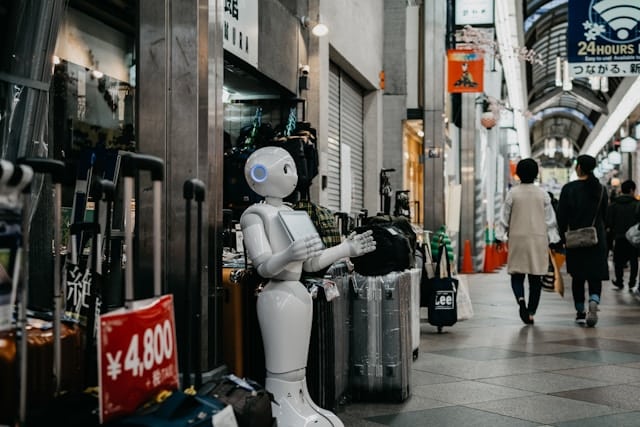How Is AI Being Used to Enhance User Interface Design?

In the rapidly evolving landscape of digital technology, artificial intelligence (AI) brings an exciting new dimension to user interface (UI) design. This innovation is transforming the way we interact with our devices, creating a more intuitive and seamless user experience. But exactly how is AI being utilized to enhance UI design? In this article, we will explore the role of AI in improving the visual aesthetics, the interactivity, the personalization and the accessibility of user interfaces.
AI in Streamlining the Aesthetics of User Interface
Aesthetics, often understated, play a crucial role in UI design. They influence how we perceive and interact with the interface. A visually appealing UI not only attracts users but also enhances usability. With AI, designers are breaking the barriers of creativity while maintaining high usability standards.
A lire aussi : What Technologies Are Making Virtual Concerts a Reality?
In the world of UI design, AI is employed to generate design suggestions based on user data. By analyzing previous user interactions and preferences, AI algorithms can suggest color schemes, layouts, font styles, and other design elements that are likely to appeal to the user. This process significantly saves time and resources in the design process.
Moreover, AI tools like the Adobe Sensei leverage machine learning to create stunning visuals. These tools analyze a vast repository of images to generate design elements that align with the overall look and feel of the user interface. This automation reduces the tedious process of manual design, allowing designers to focus on other crucial aspects.
A découvrir également : Can Smart Clothing Technology Monitor Athletes’ Biometric Data?
AI Enhancing User Interactivity
Interactivity is the backbone of any user interface. It’s what makes the UI engaging and functional. AI has significantly enhanced this aspect of UI design, providing a more immersive and intuitive user experience.
Conversational AI, like chatbots and voice assistants, are a prime example. These AI-powered tools interact with users in real-time, providing instant responses and assistance. They analyze user input, process it, and generate appropriate responses, offering a human-like interaction.
Furthermore, AI can predict user behavior based on past interactions, thereby offering proactive assistance. For example, an AI-powered app can analyze a user’s browsing patterns and suggest relevant products or services. This level of personalization enhances user engagement and satisfaction.
AI-driven Personalization in UI Design
Personalization is another essential aspect where AI is making a significant impact. AI algorithms analyze user behavior, preferences, and patterns to create personalized interfaces.
For example, popular streaming platforms like Netflix and Spotify use AI to suggest personalized content based on users’ viewing or listening history. Similarly, eCommerce websites use AI to offer product recommendations tailored to each user’s preferences and past purchases.
AI’s ability to analyze large volumes of data in real-time makes it possible to adapt the user interface based on each user’s unique preferences. This results in a personalized experience that is more engaging and user-friendly.
Bridging Accessibility Gap with AI in UI Design
Accessibility in UI design ensures that digital products are usable by all people, regardless of their abilities or disabilities. AI is playing a critical role in improving the accessibility of user interfaces.
For instance, AI-powered tools can analyze a user interface and suggest improvements to make it more accessible. These suggestions can range from increasing color contrast for better visibility to adding alternative text for images to aid visually impaired users.
Additionally, AI technologies like voice recognition and text-to-speech offer an alternative means of interaction for users with physical disabilities. These technologies convert spoken language into text and vice versa, allowing users to interact with the user interface using voice commands or listening to the content.
In conclusion, AI is revolutionizing the realm of UI design, making it more user-centric, intuitive, and accessible. As AI technology continues to evolve, we can expect more innovations that will further enhance the user interface design.
AI Tools for UI Designers
Designers are also finding it easier to do their job with the help of AI. From generating design inspirations to automating repetitive tasks, AI tools are proving to be indispensable to UI designers.
Design platforms like Adobe XD and Sketch incorporate AI to automate design tasks. These tools use AI to analyze design patterns and suggest improvements, thereby reducing the time and effort required for manual design.
Furthermore, AI tools like Canva’s Design suggestion feature use AI to generate design ideas based on user input. This assists designers in creating visually appealing designs that resonate with the user’s preferences.
AI is not just enhancing the user interface; it is also making the design process more efficient. With AI, designers can focus more on ideation and creativity, leaving the monotonous tasks to AI.
The Future of AI in UI Design
Looking towards the future, it’s clear that AI will continue to play a significant role in the evolution of UI design. As AI technologies become more advanced, their integration with UI design is expected to enhance more than just aesthetics, interactivity, personalization, and accessibility.
One area where we can expect substantial growth is in predictive design. This involves AI algorithms forecasting user needs based on past behaviors and actions. For example, a fitness app might predict that a user will want to log a workout immediately after leaving a gym location, prompting a workout log interface to appear at the right time.
Moreover, researchers are also exploring the potential of AI in creating adaptable or morphing interfaces. These interfaces would automatically adjust their layout, color scheme, or even functionality based on the user’s context, such as their location, time of day, current task, or even mood.
In addition, the growth of AI in UI design will also be guided by ethical considerations. As AI systems handle more user data and make more decisions on their behalf, designers will need to ensure these systems are transparent, fair, and respect user privacy. This means designing interfaces that clearly communicate how AI systems use user data and make decisions.
Conclusion
In conclusion, AI is indeed revolutionizing the realm of UI design. From enhancing visual aesthetics and interactivity to personalizing user experiences and improving accessibility, AI is making user interfaces more user-centric. By harnessing the power of AI, designers are not only able to create visually appealing and intuitive interfaces, but also deliver more personalized and accessible experiences.
The future holds even more potential, with the presence of AI in UI design likely to grow more pervasive and influential. As we navigate this future, it will be crucial to ensure that the integration of AI into UI design consistently respects user privacy and adheres to ethical standards. Only then can we fully harvest the benefits of AI in UI design, creating experiences that are truly intelligent, intuitive, and user-centric.
